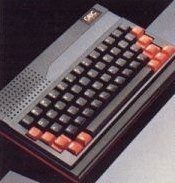

ATMOS TECHNICAL SPECIFICATIONS
![]()
| Oric
offer 16K and 48K Atmos models, both featuring 'typewriter'
style keyboards and we've included detailed
specifications of the computer's capabilities for you
below. You can connect the MicroDisc and Four Colour Printer to the Atmos to create a professional computer system. If you'd like to know the full details of the Atmos and the Oric peripherals — read on... 6502A Microprocessor with 16K ROM containing BASIC interpreter and operating system. RAM uses state of the art dynamic memories for high board density and low power dissipation. 16K Byte or optionally 48K Byte. 48K model contains 64K of RAM with 16K overlaid by ROM. External control signal allows the use of full 64K RAM or may be used to externally increase ROM. Keyboard 57 moving keys with tactile feedback. Full upper and lower case with correctly positioned space bar. Full typewriter pitch. Key layout is standard computer type with ESC, CTRL, RETURN and additional cursor control keys. All keys have auto repeat. Display Will drive a PAL UHF
colour or black and white television receiver.
Approximately Channel 36. RGB output also provided on DlN
socket with 270° configuration. Sound Uses internal
loudspeaker and amplifier and can also be connected to
external Hi-Fi system via a DIN connector. A three
channel sound synthesizer (The General Instrument 8912)
as used in arcade games machines which can produce
musical notes from sub-sonic to supersonic frequencies.
Envelope of sound output is programmable and can be used
to synthesize various musical instruments. Cassette Interface Connect via
DIN socket. Uses Tangerine format which has been field
proven over A Schmitt trigger circuit is used on the tape input to remove noise. The Tangerine format is so good it is the one other manufacturers are copying. AII types of information may be saved such as programs, data, arrays, blocks of memory screen displays. After saving, correct recording may be verified before deleting information in memory. Remote motor control of tape recorder is provided; essential for the loading and saving of data files. Available commands are CLOAD, CSAVE (for programs and memory dumps) STORE, RECALL (for arrays). Both programs and arrays may have a filename up to 16 characters. Arrays may be string integer or real. Various command extensions can be used such as S for slow speed, V for verify (CLOAD and CSAVE only) AUTO for autorunning of programs. A and E for start and end of memory dumps. Expansion Port and Micro Drive Interface Full data, address and control information forthe6502A Micro Processor; for connection of add-ons. Can also be used for user designed hardware interfaces. Useful control lines allow RAM and ROM to be externally expanded (ideal for adding ROM cartridges). Printer Port Standard
Centronics parallel interface allows connection of a
multitude of different Reset Machine resets to
character mode on power up and clears program memory. A
key on the base of the machine provides a warm start
which will return to command mode (after a program crash
or never ending loop) without destroying program or data. String Operations and Functions Strings may be up to 255 characters in length. There are a number of functions to manipulate strings: ASC, CHR$, LEFT$, LEN, MID$, RIGHT$,TAB,VAL Strings may be concatenated (joined together) using +. Strings may be computed using, =, <, >,=<,= >, 0. Variables Variable names may
be of any length, although only the first two characters
are acted upon. They may consist of combinations of the
letters A-Z and numbers 0-9. The following suffixes may
be applied to variable names. Dimensions |
Click here for more info on ports
| BASIC Keywords ABS AND ASC ATN CALL CHAR CHR$ CIRCLE CLEAR CLOAD CLS CONT COS CSAVE CURMOV CURSET DATA DEEK DEF DIM DOKE DRAW EDIT END EXP EXPLODE FALSE FILL FN FOR...TO... (STEP) NEXT FRE GET GOSUB GOTO GRAB HEX$ HIMEM HIRES IF...THEN... (ELSE) INK INPUT INT KEY$ LEFT$ LEN LET LIST LLIST LN LOG LORES LPRINT MID$ MUSIC NEW NOT ON OR PAPER PATTERN PEEK PI PING PLAY PLOT POINT POKE POP POS PRINT PULL RECALL READ RELEASE REM REPEAT RESTORE RETURN RIGHTS$ RND RUN SCRN SGN SHOOT SIN SOUND SPC SQR STOP STORE STR$ TAB TAN TEXT TROFF TRON TRUE USR VAL WAIT ZAP |
Please note: More BASIC commands are available when using Sedoric.
© Copyright 2000 by S.D.Marshall email me